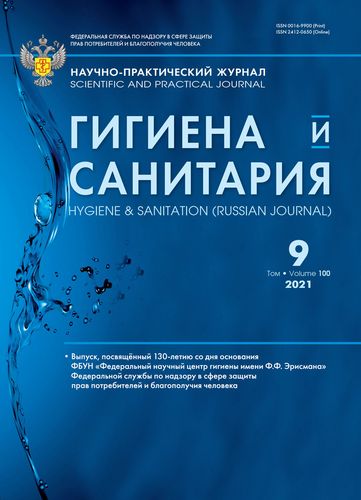Biological monitoring — as a method of hygienic assessment of the effects of pesticides on workers
- Authors: Rakitskii V.N.1, Mikheeva E.N.1, Grechina M.S.1
-
Affiliations:
- Federal Scientific Center of Hygiene named after F.F. Erisman, Federal Service for Supervision of Consumer Rights Protection and Human Welfare
- Issue: Vol 100, No 9 (2021)
- Pages: 1004-1008
- Section: METHODS OF HYGIENIC AND EXPERIMENTAL INVESTIGATIONS
- Published: 06.09.2021
- URL: https://rjraap.com/0016-9900/article/view/639019
- DOI: https://doi.org/10.47470/0016-9900-2021-100-9-1004-1008
- ID: 639019
Cite item
Full Text
Abstract
Introduction. When conducting registration tests of the active substances of pesticides, it is essential to assess the risk for workers using these pesticide preparations in field experiments, where there is a direct human interaction with a potentially hazardous substance. The use of personal protective equipment and strict adherence to the regulations for the use of pesticide preparations cannot guarantee complete protection against contact with aggressive components. Biomonitoring occupies a special place in studies on the assessment of exposure of workers with pesticides, which makes it possible to assess the actual, rather than potential, absorption of a biologically active substance.
Purpose of the work. Study of biomaterial (urine) of employees participating in field experiments when working with drugs based on active substances of the neonicotinoid group to determine their trace amounts by high performance liquid chromatography with a mass detector and risk assessment for those working with these pesticides.
Materials and methods. Preparation of urine samples and their subsequent analysis for the content of residual amounts of acetamiprid, imidacloprid, thiamethoxam and its metabolite clothianidin were performed in accordance with the certified method “Measurement of the concentration of active substances of pesticides of the neonicotinoid class in urine”. The measurements were carried out using a method based on a tandem high performance liquid chromatography with a triple quadrupole mass detector, which makes it possible to estimate the minimum levels of active substances by two transitions of the parent ions (for quantitative calculation and confirmation by the ionic ratio). Electrostatic sputtering was used as a source of ionization; measurements were carried out in the multiple reaction monitoring mode.
Results. The detected levels of imidacloprid in the urine of the researchers correspond to the data on the exposure assessment obtained from the results of measuring the concentration of this active substance in the air of the working area, as well as in washes from the skin of workers in agriculture. The maximum content of imidacloprid was revealed during the sowing of the etched seed material.
Conclusion. Based on the data obtained, it was concluded that biomonitoring is the preferred method in a production environment due to its simplicity and sufficient information content.
Contribution:
Rakitskii V.N. — concept and design of the study;
Mikheeva E.N. — research concept and design;
Grechina M.S. — collection and processing of material, statistical analysis, writing of the manuscript, collection of literature data.
All authors are responsible for the integrity of all parts of the manuscript and approval of the manuscript final version.
Conflict of interest. The authors declare no conflict of interest.
Acknowledgement. The study had no sponsorship.
Keywords
About the authors
Valerii N. Rakitskii
Federal Scientific Center of Hygiene named after F.F. Erisman, Federal Service for Supervision of Consumer Rights Protection and Human Welfare
Author for correspondence.
Email: noemail@neicon.ru
ORCID iD: 0000-0002-9959-6507
Russian Federation
Elena N. Mikheeva
Federal Scientific Center of Hygiene named after F.F. Erisman, Federal Service for Supervision of Consumer Rights Protection and Human Welfare
Email: mikheevaen@fferisman.ru
ORCID iD: 0000-0002-9633-5686
MD, researcher of the Federal Scientific Center of Hygiene named after F.F. Erisman, Federal Service for Supervision of Consumer Rights Protection and Human Welfare, Mytishchi, 141014, Russian Federation.
e-mail: mikheevaen@fferisman.ru
Russian FederationMarina S. Grechina
Federal Scientific Center of Hygiene named after F.F. Erisman, Federal Service for Supervision of Consumer Rights Protection and Human Welfare
Email: noemail@neicon.ru
ORCID iD: 0000-0003-3324-5090
Russian Federation
References
- Rakitskiy V.N., Bereznyak I.V. Russia risk assessment model for working with pesticides. In: Proceedings of the XI All-Russian Congress of Hygienists and Health Officers. Part 2 [Materialy XI Vserossiyskogo s”ezda gigienistov i sanitarnykh vrachey. Chast’ 2]. Moscow; 2012: 209–12. (in Russian)
- MU 1.2.3017-12. Assessment of risk of impact of pesticides on the working. Moscow; 2012. (in Russian)
- OCDE/GD(97)148. Guidance document for the conduct of studies of occupational exposure to pesticides during agricultural application. Available at: https://www.oecd.org/officialdocuments/publicdisplaydocumentpdf/?doclanguage=en&cote=ocde/gd(97)148
- Ermolova L.V., Prodanchuk N.G., Zhmin’ko P.G., Lepeshkin I.V. Comparative toxicologic characteristics of new neonicotinoid insecticides. Sovremennye problemy toksikologii. 2004; (2): 4–7. (in Russian)
- Eremina O.Yu., Lopatina Yu.V. Prospects for the use of neonicotinoids in agriculture in Russia and neighboring countries. Agrokhimiya. 2005; (6): 87–93. (in Russian)
- Boyko T.V. Toxicokinetic features of neonicotinoid of Confidor extra in the organism of rats. Vestnik NGAU (Novosibirskiy gosudarstvennyy agrarnyy universitet). 2013; (1): 74–8. (in Russian)
- Calderón-Segura M.E., Gómez-Arroyo S., Villalobos-Pietrini R., Martínez-Valenzuela C., Carbajal-López Y., Calderón-Ezquerro Mdel C., et al. Evaluation of genotoxic and cytotoxic effects in human peripheral blood lymphocytes exposed in vitro to neonicotinoid insecticides news. J. Toxicol. 2012; 612647. https://doi.org/10.1155/2012/612647
- Mohamed F., Gawarammana I., Robertson T.A., Roberts M.S., Palangasinghe C., Zawahir S., et al. Acute human self-poisoning with imidacloprid compound: a neonicotinoid insecticide. PLoS One. 2009; 4(4): e5127. https://doi.org/10.1371/journal.pone.0005127
- Zeng G., Chen M., Zeng Z. Risks of neonicotinoid pesticides. Science. 2013; 340(6139): 1403. https://doi.org/10.1126/science.340.6139.1403-a
- Matsuda K., Buckingham S.D., Kleier D., Rauh J.J., Grauso M., Sattelle D.B. Neonicotinoids: insecticides acting on insect nicotinic acetylcholine receptors. Trends Pharmacol. Sci. 2001; 22(11): 573–80. https://doi.org/10.1016/s0165-6147(00)01820-4
Supplementary files









